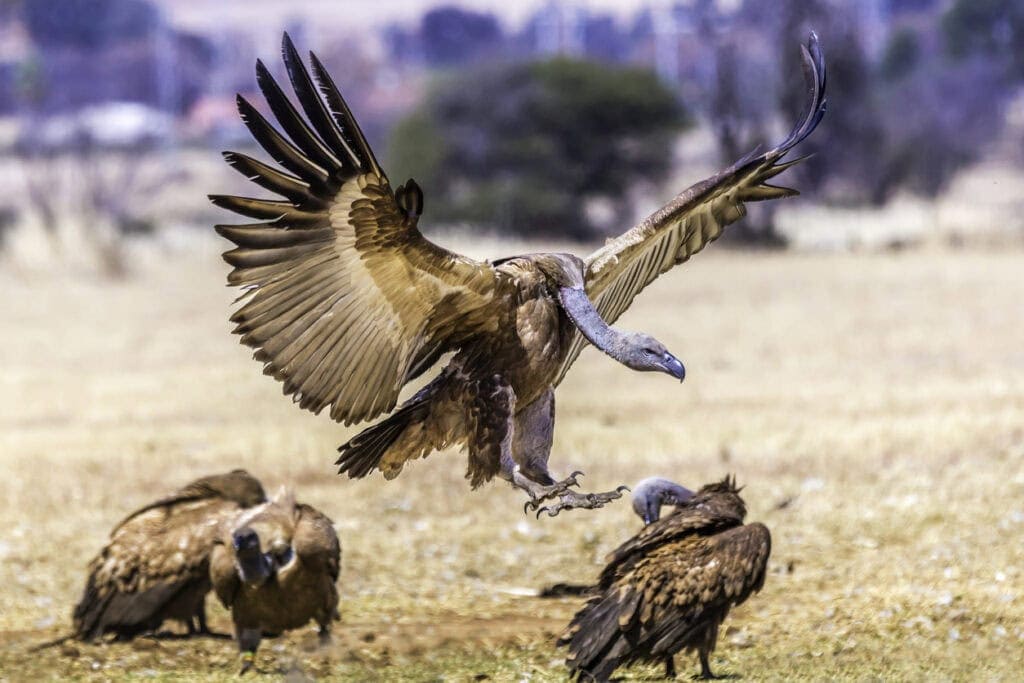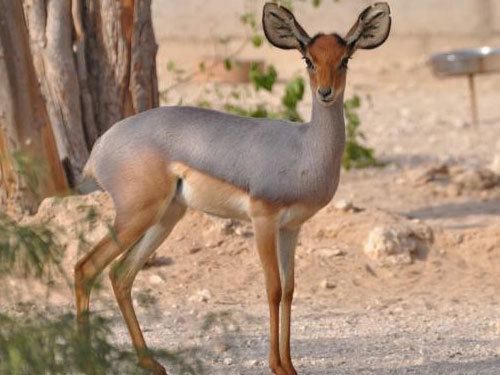Renowned for its rich biodiversity in both habitat and wildlife, Africa is home to an array of animal species that evoke both wonder, awe and admiration. However, due to a combination of factors such as habitat loss, poaching, climate change, and human-wildlife conflicts, many of these iconic creatures now find themselves threatened by extinction.
From the powerful African elephant to the truculent black rhino, the majestic lion to the fleet-footed cheetah, Africa’s endangered animals are a poignant reminder of the fragility of our natural world. Their plight reminds us of the urgent need for conservation efforts to safeguard these irreplaceable treasures.
1. African Wild Dogs (Lycaon pictus)
Description: As a result of their scientific name, African wild dogs are also known as painted wolves. They’re carnivorous and are excellent hunters. They have multi-coloured coats of red, black, brown, yellow and white, large, round ears, and a lean, powerful build. Unlike domestic dogs, they have only four toes on each foot – they don’t have dew claws!
Population: Estimates vary, but the numbers of this once common animal, found all over sub-Saharan Africa, have declined to between 3,000 to 6,600 individuals.
Habitat: African wild dogs prefer wide-open plains and savannahs. They do best in areas with low human density and ample prey availability.
Location: They are mostly found in fragmented populations in Botswana, Tanzania, South Africa, and parts of Zimbabwe and Zambia. Several conservation initiatives are underway to reintroduce and increase populations in protected areas and wildlife reserves.
2. Mountain Gorillas (Gorilla beringei beringei)
Description: Mountain gorillas are a subspecies of the eastern lowland gorilla (Gorilla beringei graueri). They have thick, long fur, a stocky, powerful build, broad chests, long muscular arms, and prominent heads with pronounced brow ridges. The renowned silverbacks are incredibly powerful and impressive.
Population: Mountain gorillas are critically endangered and their numbers are perilously low. However, thanks to intensive conservation efforts, and the inestimable contribution of people like Dian Fossey, their population has risen to around 1,004 individuals today.
Habitat: Mountain gorillas are found in the cool and misty montane cloud and bamboo forests at altitudes from 2,500 to 4,000 metres. They generally live on the ground but can climb trees. Their diet consists mainly of leaves, shoots, stems, fruit, insects, and the occasional small animal.
Location: Mountain gorillas are found in two isolated regions in Africa. The first is the Virunga Mountains in the Democratic Republic of Congo, Rwanda, and Uganda. The other is in Uganda’s Bwindi Impenetrable National Park. Though protected, these regions are unfortunately vulnerable to human encroachment, poaching, and civil unrest.
3. Pangolin (Pholidota)
Description: Pangolins are unique for their protective keratin scales, for which they are poached mercilessly. They are, in fact, the world’s most trafficked animals. They are solitary and nocturnal animals, mainly feeding on ants and termites.
Population: The exact numbers of pangolins worldwide are unknown, but all eight species of pangolin are recognised to be under threat. The four African species, the black-bellied, white-bellied, giant ground, and Temminck’s ground pangolin, range from vulnerable to critically endangered.
Habitat: Pangolins are found in a variety of African habitats, including grasslands, forests, and savannahs.
Location: African pangolins are distributed across the continent. The Temminck’s ground pangolin is found in Eastern and Southern Africa, including South Africa, Botswana, and Zimbabwe.
4. Hirola Antelope (Beatragus hunteri)
Description: Also known as the ‘hunter’s hartebeest’ or ‘hunter’s antelope’, the hirola is a medium-sized antelope with long, slender horns and distinctive white facial markings.
Population: Numbers vary, but with a population of between 300 – 600 individuals left, they are critically endangered and the world’s most threatened antelope. Their survival is threatened by poaching, drought and habitat loss.
Habitat: The hirola antelope inhabits the grasslands and savannahs of Eastern Africa.
Location: Most of this antelope’s remaining population is concentrated in reserves along the Kenya-Somalia border.
5. Riverine Rabbit (Bunolagus monticularis)
Description: The riverine rabbit is a small, nocturnal mammal with dark, reddish-brown fur and a distinctive white ring around each eye. Unlike many other rabbits, the females only have one baby per year.
Population: Exact figures aren’t available, but it’s believed that currently no more than about 500 riverine rabbits survive in the wild. This makes it one of the world’s most endangered animals.
Habitat: The riverine rabbit is found in an extremely limited distribution area. They only live in the dense, thicket-like vegetation along seasonal rivers in the semi-desert Karoo of South Africa’s Northern Cape Province.
Location: The Anysberg Nature Reserve and the Sanbona Wildlife Reserve in the Western Cape Province are key habitats for this species.
6. Black Rhino (Diceros bicornis)
Description: Recognised by its two prominent horns and thick, hairless skin, the black rhino is a potent symbol of Africa’s wildlife. Many conservation efforts have been launched to protect these animals.
Population: Black rhinos are still critically endangered though current numbers have increased to about 6,195 animals (January, 2023).
Habitat: Black rhinos are found in diverse habitats, including thorn scrub, savannahs, thickets, dry forest, bushland as well as riverine woodlands and marshes.
Location: Countries such as South Africa, Namibia, Zimbabwe, Tanzania, and Kenya have populations of black rhinos. Key reserves to see them include Etosha National Park in Namibia, and the Serengeti National Park in Tanzania. In South Africa the Kruger National Park is a prime location to see black rhinos, as are
the Sabi Sand, Hluhluwe-Imfolozi and Mkhuze Game Reserves.
7. Cape Vulture (Gyps coprotheres)

The Cape griffon vulture is a vulnerable Old World vulture that is endemic to parts of South Africa, Lesotho, Botswana, and northern Namibia. They are large raptors, with a wingspan that exceeds 2.5 metres. They lay only one egg per year, and are characterised by pale-coloured underparts, dark tail and flight feathers, and an almost bare head and neck.
Their keen eyesight and strong beaks make them superb scavengers that play crucial roles in maintaining a healthy environment. To spread awareness of their vital role, the first Saturday of September has been designated International Vulture Awareness Day each year.
Population: The Cape vulture is classified as vulnerable with a decreasing population trend. As of 2021, it’s estimated that fewer than 5,000 breeding pairs remain in the wild. Cape vultures are threatened by habitat loss, poisoning, and power line collisions.
Habitat: They’re predominantly found in open grassland and semi-desert regions, and roost and nest on cliffs.
Location: The Cape vulture is endemic to southern Africa. Their range spans South Africa, Lesotho, Botswana and northern Namibia. Conservation initiatives include ‘vulture restaurants’ to provide them with safe food.
8. Beira Antelope (Dorcatragus megalotis)

Description: The Beira antelope is a slender, arid-adapted and elusive dwarf antelope. It has a light browny-grey coat, white underbelly, oversized ears, and short, sharp, vertically straight horns.
Population: Precise numbers are not to hand, but it’s classified as vulnerable due to habitat destruction and hunting. Only a few thousand are thought to survive in the wild.
Habitat: Beira antelopes do best in arid and semi-arid environments, particularly bushy or rocky terrains. Their diet consists of leaves, stems, buds, succulents, herbs, grasses, flowers, and fruits.
Location: Endemic to the Horn of Africa, the Beira antelope’s range is primarily confined to parts of Somalia and eastern Ethiopia, often in isolated pockets.
9. Grey Parrot (Psittacus erithacus)
Description: The grey parrot, also referred to as the African or Congo grey parrot, is a medium to large parrot renowned for its intelligence and ability to ‘speak’. It has a large beak, whitish face, grey plumage and a striking red tail. When young their eyes are dark grey, but they end up yellow when the birds mature.
Population: Grey parrot populations have declined significantly over recent decades due to their high demand in the pet trade, and habitat loss, so now they’re classified as endangered. Illegal trafficking is still a problem.
Habitat: Their main habitat is dense rainforests, but they’re also found in mangroves, wooded savannahs, and even cultivated areas. They migrate based on the availability of food and suitable nesting sites.
Location: Their range includes the Ivory Coast, Ghana, Nigeria, Cameroon, and the Democratic Republic of the Congo. Due to deforestation and habitat degradation, their populations have become fragmented.
10. Ethiopian Wolf (Canis simensis)
Description: The Ethiopian wolf is Africa’s most endangered carnivore. It’s a slender, long-legged canid with a reddish-brown coat and white on its tail, face and throat. It has a pointed muzzle, and large, erect ears. It’s similar in size and colouring to a fox, which explains its other names of Simien fox and Simien jackal.
Population: It’s critically endangered, with only about 366 individuals surviving due to habitat destruction, diseases (often transmitted from domestic dogs), and hunting.
Habitat: Adapted to high altitudes, Ethiopian wolves are found in Afro-Alpine grass- and heathlands, where rodents, their main prey, are abundant.
Location: They’re endemic to the Ethiopian Highlands, and are restricted to a few isolated pockets in the Bale and Simien mountains, particularly the Bale Mountains National Park.
Prominent Conservation Efforts and Organisations
As you can see, many of Africa’s animals are under desperate pressure, and for sure they need every bit of help they can get! If you want to help, here are just some of the organisations that do inestimably valuable work in trying to help the endangered animals of the world:
- African Wildlife Foundation (AWF): AWF focuses on conserving Africa’s wildlife by addressing threats such as habitat loss and poaching, engaging with local communities, and promoting conservation-friendly policies.
- Save the Rhino International (SRI): This organisation works to stop poaching, address habitat loss and engage local communities in this struggle. They also focus on education and involving the youth.
- Wildlife Conservation Network (WCN): WCN supports conservationists and organizations across Eastern and Southern Africa, focusing on species-specific projects and community engagement.
Cheetah Conservation Fund (CCF): The CCF is dedicated to saving cheetahs in the wild, through research, education and protection/conservation - Peace Parks Foundation: This organisation establishes transfrontier conservation areas, connecting protected areas across international borders to create larger, more sustainable ecosystems for wildlife.
- Desert Lion Conservation: This small, non-profit organisation works for the conservation of desert-adapted lions in the Namib desert.
- African Parks: African Parks manages national parks and protected areas across Africa, focusing on ecosystem restoration, wildlife reintroduction, and community development.
- Save the Elephants: Based in Kenya, this organisation conducts research, promotes anti-poaching efforts, and advocates for policies that protect elephants and their habitats.
Author: Susan Veldman
Published:
Last Update: